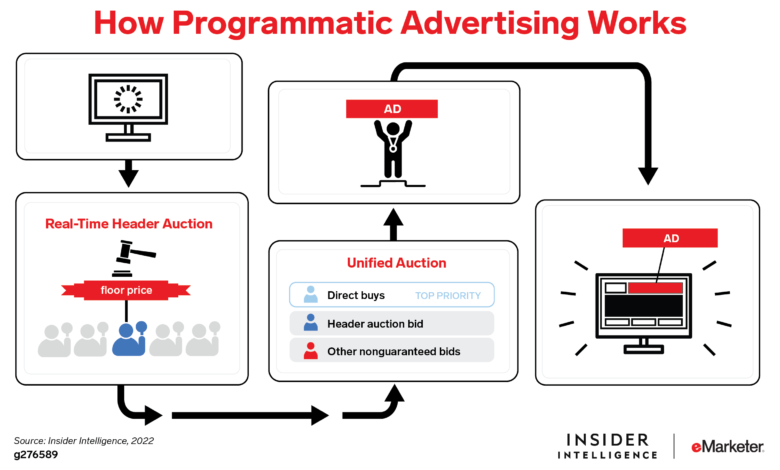Exploring the World of Programmatic Advertising

Introduction
Programmatic advertising represents a significant shift in the way advertising space is bought and sold. Powered by algorithms and technologies, it automates the decision-making process of media buying by targeting specific audiences and demographics. This method not only streamlines the placement of ads but also optimizes the marketing efforts of businesses, ensuring that the right message reaches the right audience at the right time.
What is Programmatic Advertising?
Programmatic advertising involves the automatic buying and selling of online advertising space through an exchange, connecting advertisers to publishers. This process uses artificial intelligence technologies and real-time bidding for inventory across mobile, display, video, and social channels. By automating the process, it ensures efficiency and quicker execution, which helps advertisers and publishers optimize their strategies and investments.
Understanding Programmatic Display Advertising
Programmatic display ads refers to the use of programmatic media buying technologies to distribute display ads online. Display ads are typically image-based and are a popular way to build brand awareness and customer recall. Unlike traditional methods, which involves negotiations and manual orders, programmatic display ads are bought in real-time and targeted more precisely according to user behavior, demographics, and psychographics.
Definition
Programmatic advertising is defined as the automated buying and selling of online ad space using data and algorithms to serve ads to the right user at the right time and at the right price. It is highly efficient, minimizing human negotiation and errors, and maximizes the relevance and effectiveness of ads through sophisticated targeting and real-time adjustments.
Programmatic Advertising Explained
At its core, programmatic advertising utilizes advanced algorithms to analyze a visitor’s behavior, allowing advertisers to display ads that are more likely to be of interest to the individual, thereby increasing the likelihood of user engagement. For example, if a user has been searching for flights to Tokyo, they may be shown ads from airlines offering flights to Japan or articles about traveling to Tokyo.
Examples
- Real-Time Bidding: This is a type of programmatic ad buying that happens in real-time. It involves an automatic auction, where the highest bidder wins the ad space. This process is done in milliseconds, as a user loads a webpage.
- Direct Deals: These are negotiated deals that still leverage programmatic technology but are agreed upon in advance between the advertiser and the publisher. These deals often guarantee certain levels of inventory and pricing.
- Programmatic TV: Programmatic technology is not limited to online spaces; it is also used for buying and placing TV ads. It allows advertisers to utilize data to target audiences more precisely and to buy ad space across a range of platforms, from traditional TV to streaming services.
Programmatic Digital Advertising
In the digital realm, programmatic advertising extends across a wide range of media and formats. Beyond display ads, it includes video, mobile, audio, and even digital out-of-home advertising. Each format has its own set of strategies and best practices, yet all benefit from the efficiency and precision of programmatic technologies.
What is Programmatic Display Advertising?
Programmatic display advertising involves automated technology and algorithms to buy display ad space in real-time, based on the specific targeting parameters set by advertisers. This can include factors like demographics, interests, behaviors, and more, making ads more relevant to the individuals who see them.
The Benefits of Programmatic Advertising
- Efficiency: Automates the buying process and reduces manpower and negotiation.
- Targeting: Advanced targeting options ensure that ads are served to the right audience, enhancing the effectiveness of campaigns.
- Real-Time Optimization: Advertisers can adjust campaigns in real-time based on performance data, ensuring optimal performance.
- Cost-Effectiveness: With real-time bidding, advertisers can often secure ad space at a lower cost compared to traditional media buying.
Challenges
While programmatic advertising offers numerous benefits, it also comes with challenges such as privacy concerns, ad fraud, and the need for transparency. Advertisers must navigate these challenges carefully to ensure that they maintain consumer trust and maximize their advertising effectiveness.
Future Trends
The future of programmatic advertising includes the increasing use of artificial intelligence to improve ad targeting and buying efficiency, greater emphasis on privacy and secure data usage, and the expansion of programmatic advertising into new platforms like connected TV and digital out-of-home.
Conclusion
Programmatic advertising is transforming the advertising landscape, offering unprecedented efficiency and precision. By understanding and leveraging this technology, advertisers can significantly enhance the impact and efficiency of their campaigns.




